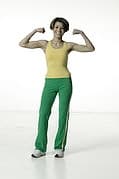Welcome to part 3, the exercise myth buster episode! It is important to dispel some myths to improve your likelihood of success and manage your expectations. Today we will be focusing on 3 major myths:
Exercise Myth 1: Focusing too much on weight lifting will reduce your flexibility.
In actuality, the opposite is true! A study of 54 subjects found that just lifting improved flexibility by 29% (if the subject did not stretch in addition to lifting) 37% (if the subject stretched immediately post-lifting), and 54% (if they stretched 8 hours after lifting.). Another study found that in the elderly, resistance training at more than 60% of 1 repetition maximum has even greater improvements than training at lower intensities. 1 When you train your muscles through a greater range than you are typically using during your day to day routine, you actually make gains in flexibility. It seems that just lifting will improve your flexibility, and just stretching may improve your flexibility, but combining both will give you the best results.
Exercise Myth 2: It is possible to reduce fat in just certain areas of your body (spot reduction).
This one has a lot of people focusing on just doing abdominal exercises in order to lose that stubborn belly fat. The truth is that it is genetically pre-determined that you will gain/lose weight in certain areas before others. For example, if you gain fat in your abdominal area, and then gain fat in your legs, you will likely lose fat in your legs before your abdominals. The goal here should be to change your overall body composition using nutrition and exercise. The work you are doing on your abdominals will make for some nice muscle toning once you have lost the weight, but do not expect it to hasten your aesthetic results.
Exercise Myth 3: Women will get bulky with weight training.
Many women express the fear of “hulking up” when it comes to beginning a weight lifting program. There are two main reasons why this is simply not going to happen. Firstly, women do not have the hormonal environment to get big as fast as men do. If you did notice any undesirable changes you could easily alter your training program to stop this. Secondly, to get large gains in muscle mass you have to train specifically for size (called hypertrophy) and have a nutrition plan dedicated towards achieving those gains. You would need to work very very hard to gain considerable muscle bulk. That being said, go ahead and move past those 5-10 pounders! You’ll be okay.
Hopefully this blog has eased your mind over some of the common myths. Be sure to read our next blog for goal setting!






